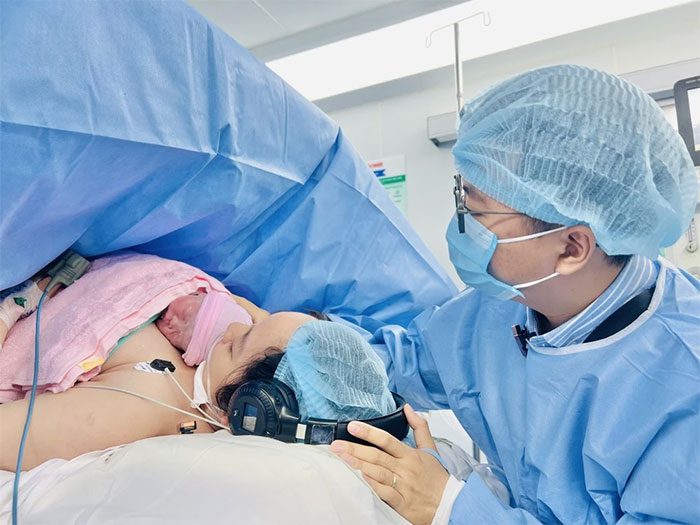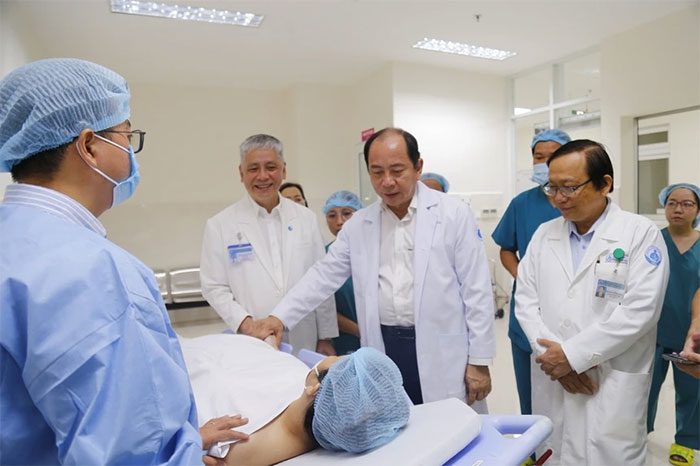After nearly two months, following a groundbreaking procedure where doctors performed heart surgery on a fetus through the mother’s uterus, a healthy baby girl has been born.
On February 29, the baby girl, weighing 2.6 kg, was safely delivered via cesarean section at Tu Du Hospital in Ho Chi Minh City. This marks the second case in Vietnam of heart surgery performed on a fetus.

A joyful moment for the family of the 27-year-old mother. This is the second successful fetal heart surgery case in Vietnam. (Photo: BVCC).
Moments of Joy
The baby girl was born at 8:15 AM, breathing on her own, with no cyanosis, and was placed skin-to-skin with her mother, who is also in good health. A follow-up ultrasound assessment indicated that no further interventions were needed at that time, including respiratory support or emergency resuscitation. The blood pumping capacity of her heart was sufficient for the baby.
The baby has now been transferred to Children’s Hospital 1 for in-depth cardiovascular monitoring.
Previously, in mid-January, a 27-year-old mother from Ho Chi Minh City was found to have an abnormal fetal heartbeat at 21 weeks. The fetus was diagnosed with progressive aortic valve stenosis.
At 29 weeks gestation, the condition of the aortic valve stenosis worsened. Experts unanimously agreed that without urgent intervention or late intervention after 30 weeks, the fetus was likely to be lost in the womb.
Two teams from Tu Du Hospital and Children’s Hospital 1 quickly performed the surgery. After two hours, blood flow through the fetal aortic valve was restored, and the condition of the pericardial effusion was well-managed, with a normal fetal heart rate.

The team at Tu Du Hospital prepares to perform a cesarean section for the 27-year-old mother. (Photo: BVCC).
Nearly two months later, when the fetus reached 37 weeks, improvements in the fetal heart condition and the mother’s stable health led the doctors to decide on a cesarean delivery.
A Special Golden Dragon Baby
“This golden dragon baby is very special,” said Dr. Tran Ngoc Hai, Director of Tu Du Hospital.
Explaining the necessity of performing the surgery at exactly 37 weeks, Dr. Tran Ngoc Hai noted that the baby’s good development during the nearly 37 weeks of monitoring was an unexpected success.
Delaying further, to when the baby was 38 or 39 weeks, could mean a physical growth score of 10 points. However, this would not be safe for the baby’s health.
At the time of the fetal heart procedure at 29 weeks, the fetus weighed less than 1 kg, and the heart size was still compatible. Waiting for a perfect score of physical development could lead to a mismatch in heart size with the weight, resulting in inadequate blood pumping, which could severely damage the heart. Therefore, at 37 weeks, when the baby weighed 2.6 kg, the chance of survival was high, making it the optimal time for surgery.
During the surgery, the Director of the Ho Chi Minh City Department of Health, Tang Chi Thuong, personally reviewed all surgical plans, neonatal resuscitation procedures, and assessed the heart condition of the baby.

PGS Tang Chi Thuong, Director of the Ho Chi Minh City Department of Health, encourages the mother before entering the operating room. (Photo: BVCC).
Simultaneously, the procedure to perform heart surgery on a third fetus through the uterus was carried out by the teams from the two hospitals. This fetus was diagnosed with a severe congenital heart defect at 17 weeks of gestation.
Doctors reported that typically, fetal heart abnormalities are detected at around 22 weeks of pregnancy. The early detection of such a severe case indicates that the heart surgery will be more challenging than the previous two cases.
In 2023, Tu Du Hospital had to terminate 3,000 pregnancies due to various defects, congenital disorders, or abnormalities. Additionally, 450 cases underwent fetal interventions for different medical conditions.
Transuterine heart surgery that saved a fetus with a severe heart defect without a pulmonary valve was recognized at the Vietnam Medical Achievement Awards 2023. This is a specialized technique, first performed in Vietnam, reopening treatment opportunities for many fetuses with heart defects.



















































